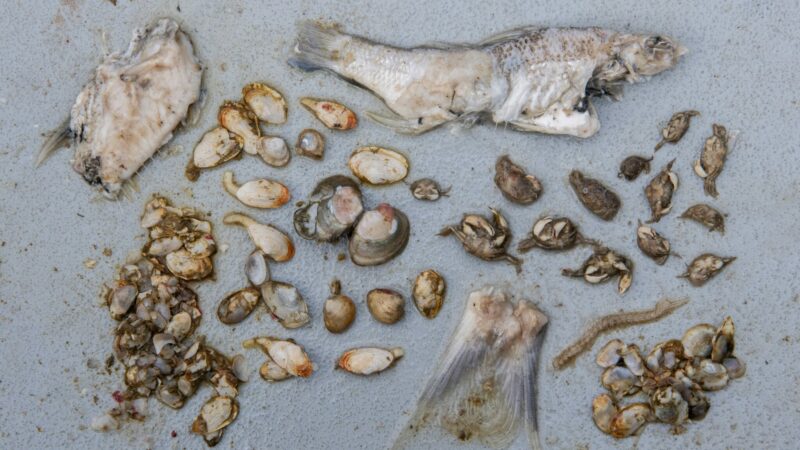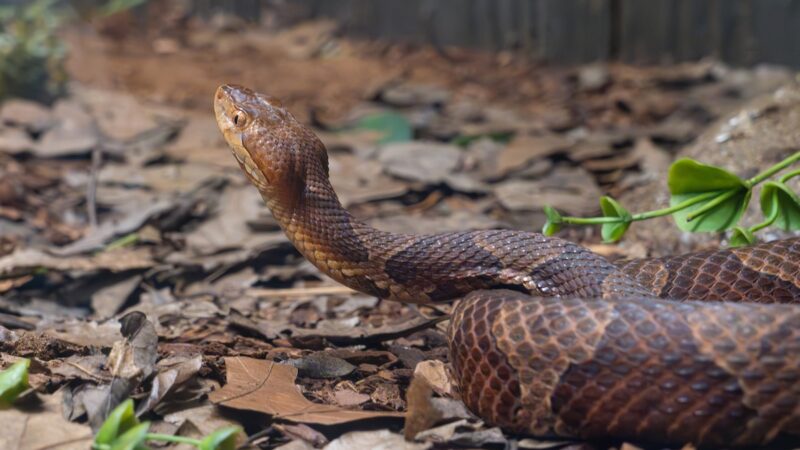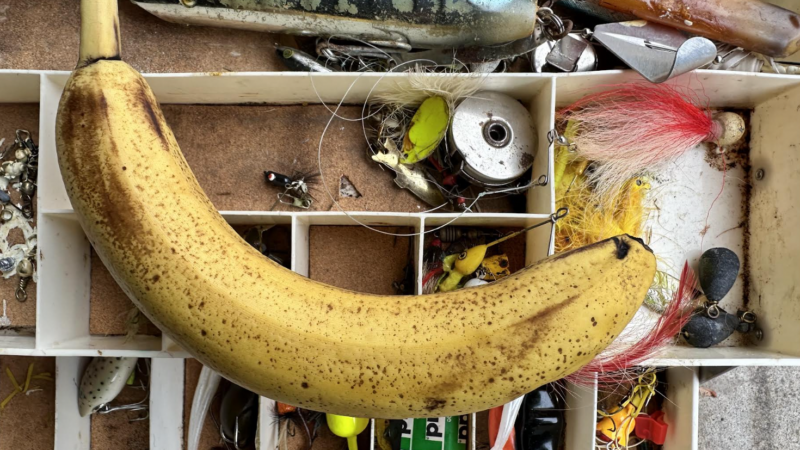Ice Fishing for Giant Sheefish in the Arctic Is a True Winter Adventure
We’d been jigging spoons for five hours. We drilled through eight feet of ice to reach water. We had yet to get a bite.
“It’s so peaceful out here,” my wife, Tiffany, whispered, not wanting to break the silence of the Arctic air. A smile and a wink were all I could muster. Our feelings were mutual.
We were sitting on the frozen sound of Kotzebue, Alaska, our breaths mingling in the still air. It was March, and the first time in 21 years that Tiffany and I had been in Alaska’s Arctic together. The evening was calm. The skies, clear.
I’d forgotten how invigorating the sensation of crisp air entering the body feels. Temperatures hovered in the mid teens. The guttural chatter of hungry ravens sporadically echoed across the frozen sea. Occasionally, the waning sound of a snowmobile could be heard in the distant village. But mostly it was quiet.
In the Beginning
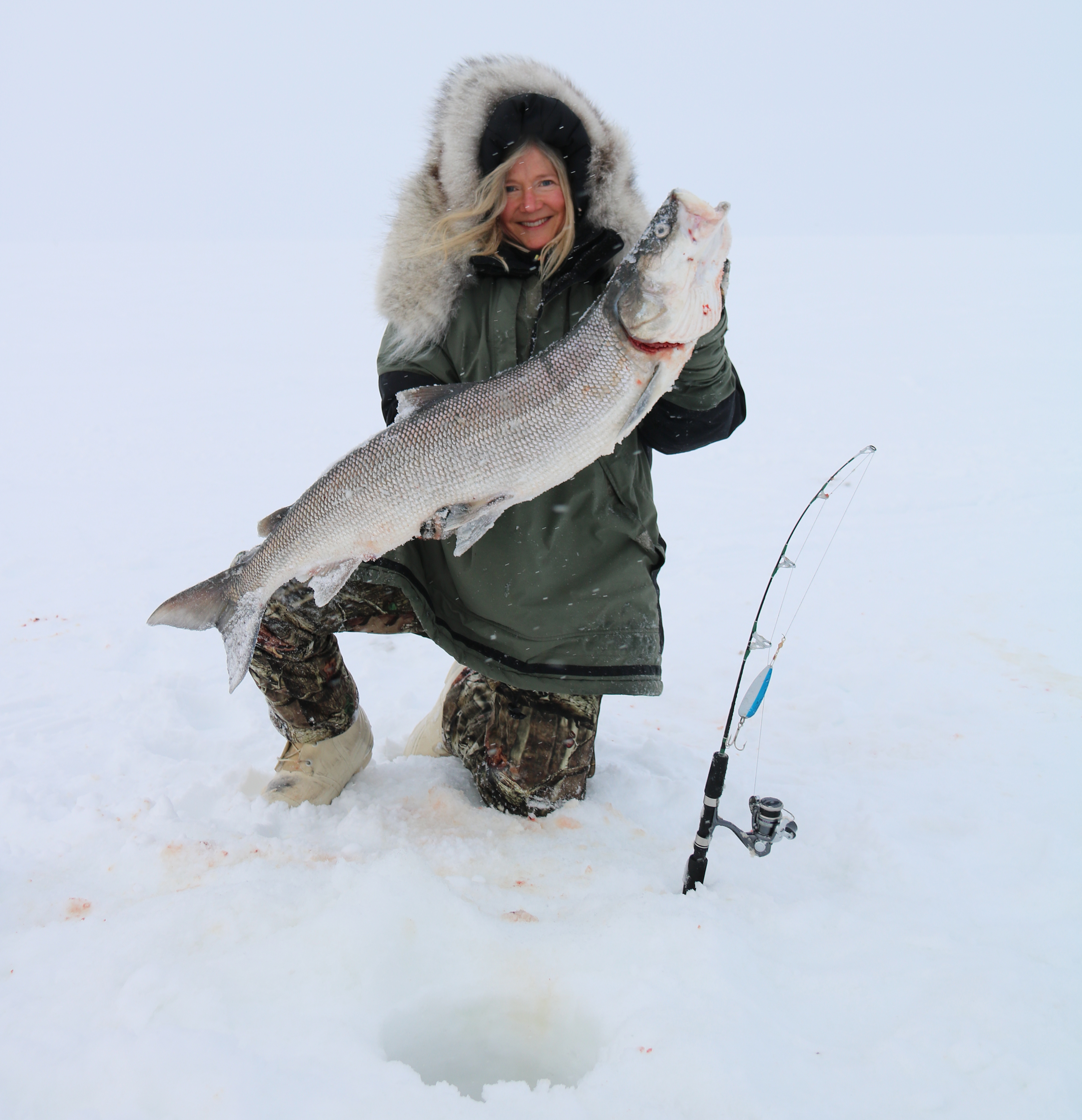
Photo by Scott Haugen
Tiffany and I grew up together. Our parents and grandparents knew one another. We both said we’d never marry anyone from our tiny hometown. Never say never.
We began our married life in Alaska’s Arctic. Fresh out of college, we moved to the small Inupiat village of Point Lay, in August of 1990. We were two of only four school teachers. Following three years in Point Lay, we relocated to Anaktuvuk Pass, one of Alaska’s most breathtaking destinations nestled into the northern reaches of the Brooks Range. We taught there for four years. We hunted and fished within sight of our home. In 1997 we moved away from the Arctic. Decades later we had sheefish to thank for bringing us back.
Despite the slow fishing that evening on Kotzebue Sound, Tiffany and I we enjoying ourselves. It was just us on the ice, the way it used to be. We missed that life.
Getting ready to call it a night, Tiff’s tiny rod doubled over. Soon she pulled her first sheefish through the 10-inch ice hole. The fish wasn’t big but it didn’t matter.
“If a sheefish this small fights this hard, I can’t wait to see what a big one does!” Tiff’ exclaimed, holding up the eight-pound fish with a smile.
Knowing sheefish travel in schools throughout the sound in search of food, we kept jigging the oversized spoons. We fished for two more hours. We didn’t get a bite. With the sun setting on the horizon of a frozen sea, it was time to head back to Kotzebue. Tomorrow would be another day.
A Father & Son Adventure
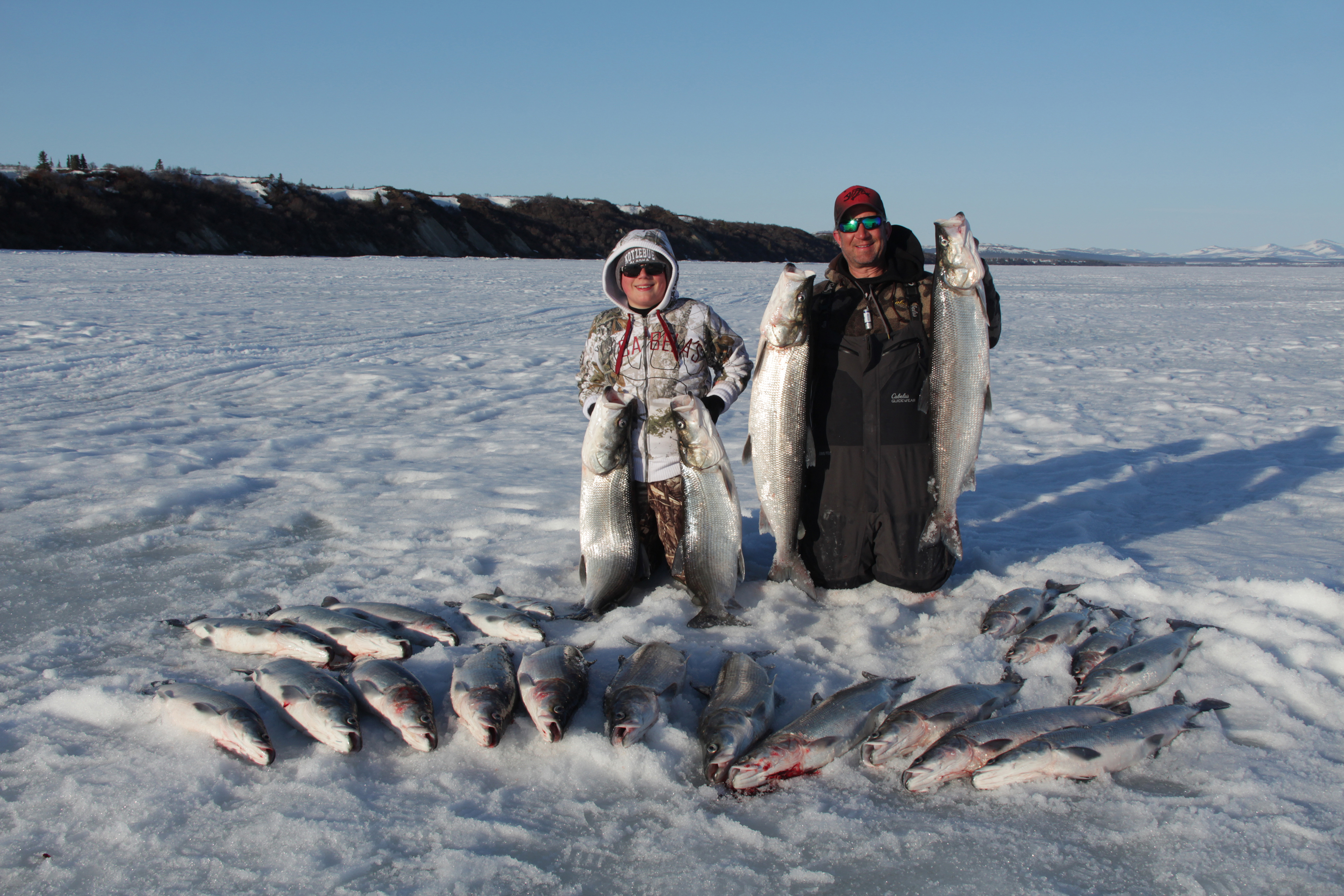
Two years before Tiffany and I chased sheefish, Kazden, our youngest son, joined me on an adventure with good friend, Lew Pagel. Kotzebue has been Pagel’s home for 18 years. Kazden had fished parts of Alaska with me before, but this was his first time above the Arctic Circle. Growing up, he’d heard stories of what Tiffany and I experienced while living in the Arctic before he was born. For 14-year-old Kazden to experience an Arctic village, was life-changing.
While driving snowmachines to where Pagel had recently caught sheefish, we saw a figure in the distance, in the middle of Hotham Inlet. We drove that direction and found a local man named Dan hunched over a single hole in the ice. Dan’s old snowmachine and tiny sled looked like they’d barely make it home. His leathery, sunbaked skin told of his time outdoors. But what really caught our attention was the pile of sheefish heads next to Dan.
We sat and watched Dan jig his niksik, a crude looking fishing stick used by the locals in this part of Alaska for centuries. Dan’s niksik was made from a willow branch. The Inupiat people fashion them from bone, caribou antler, or wood. Seconds later, Dan set the hook and yarded in a 30-plus-pound sheefish. It was giant. He gave it a quick blow to the head, slit its belly open, grabbed a full herring from it’s stomach, put it on a bare hook, dropped it through the ice and promptly caught another sheefish. He did all of this as if it was no big deal. His next fish neared 20 pounds. Kazden looked at me, wide-eyed.
Pagel had known Dan for years. He introduced us. We talked. Dan invited us to fish with him. We surrounded him with freshly drilled holes and soon we started catching fish. But they weren’t sheefish. They were bullheads, tom cod, and little flounder. Bottom fish, or some might call them trash fish.
“You’re fishing too deep,” Dan barked. “Go this far down,” he showed us by stripping line from his niksik a full body length, then half that, again. Dan caught one more fish, then nothing for a while.
“The sheefish are gone,” he said. “You can fish here, but I think they left.”
We fished a few more hours then went home empty handed.
The next morning we were back on the ice. That afternoon, Dan found us. Kazden poured the elder a cup of coffee and soon Dan and Kazden hit it off. While Dan sat on the seat of his rickety snowmachine, sipping coffee, he shared hunting and fishing stories. Kazden hung on every word. Dan told us how he marked the snowmachine trails in the fall, from Kotzebue to neighboring villages. I’d heard stories of men who do this. It’s one of the most dangerous jobs in Alaska because the ice can be unstable before winter grips it.
When Dan learned that this was our fifth day, and that we’d not caught one sheefish, he invited us to stop by his house to grab some to take home.
We asked him to fish with us. “No, there are no fish here,” Dan said, matter of factly. “Go to those hills then follow the snowmachine trail east, to the mouth of a creek, where the trees turn black,” he pointed. “You should catch fish there.” He hopped on his snowmachine and drove back to the village without another word.
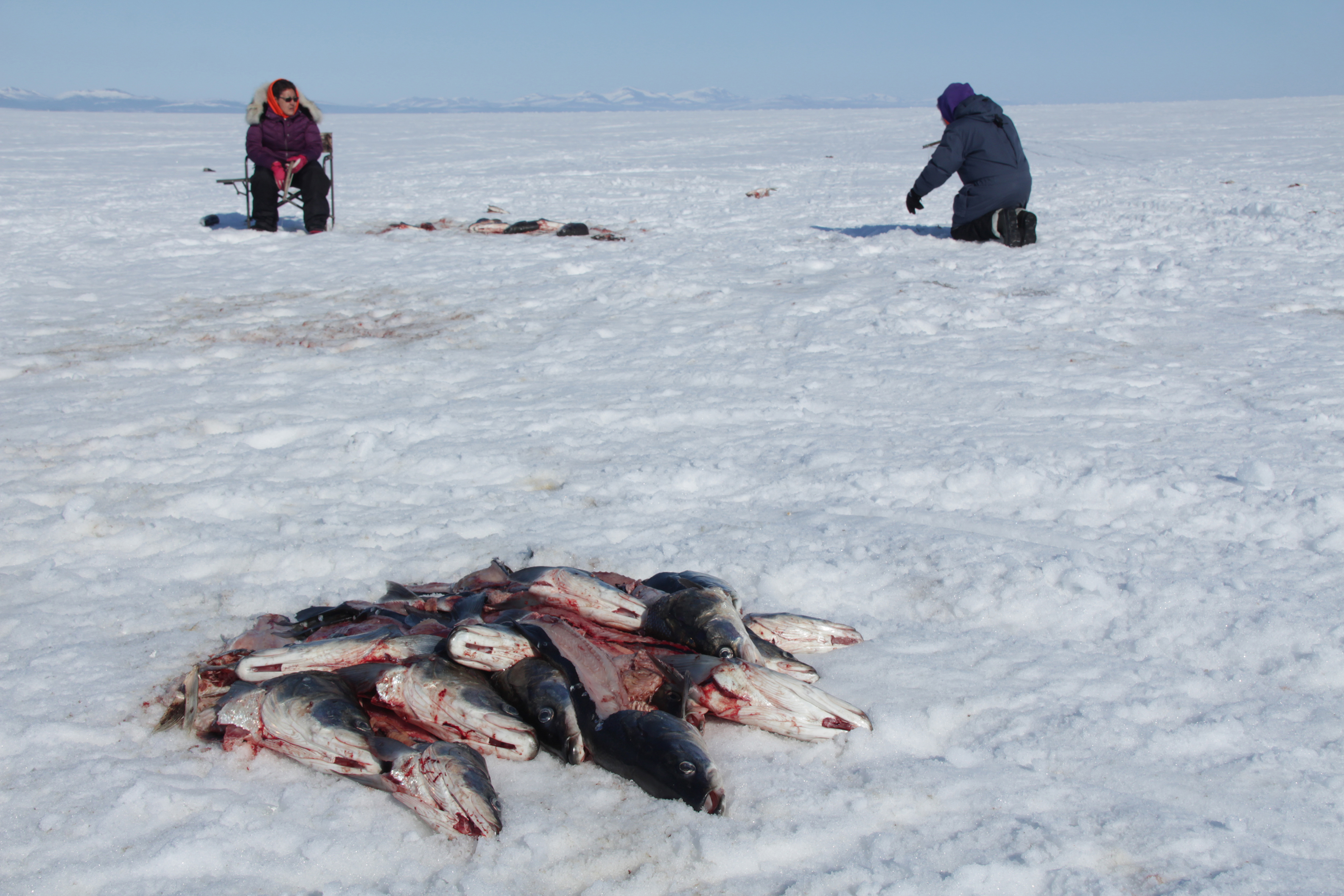
Photo by Scott Haugen
We went to where Dan instructed. We drilled three holes. Five minutes later Kazden caught his first sheefish. Over the next two hours we landed over 40 sheefish. Kazden caught several over 20 pounds, one over 30. At 7:00 p.m. we started loading sheefish on to our sleds. The Arctic air was calm, but cold, dipping below 0. It didn’t feel that cold.
“I want to move to Alaska,” Kazden told Tiffany, the moment we got home. “I love the village, the school, the wildlife, the people, Dan, everything about it,” he said. Alaska does that to a person.
Five years later we did move back to Alaska. It was Kazden’s senior year of high school. We relocated to Hyder, Alaska. There were 11 kids in the school. Kazden was the sole graduate that year.
Back on the Ice
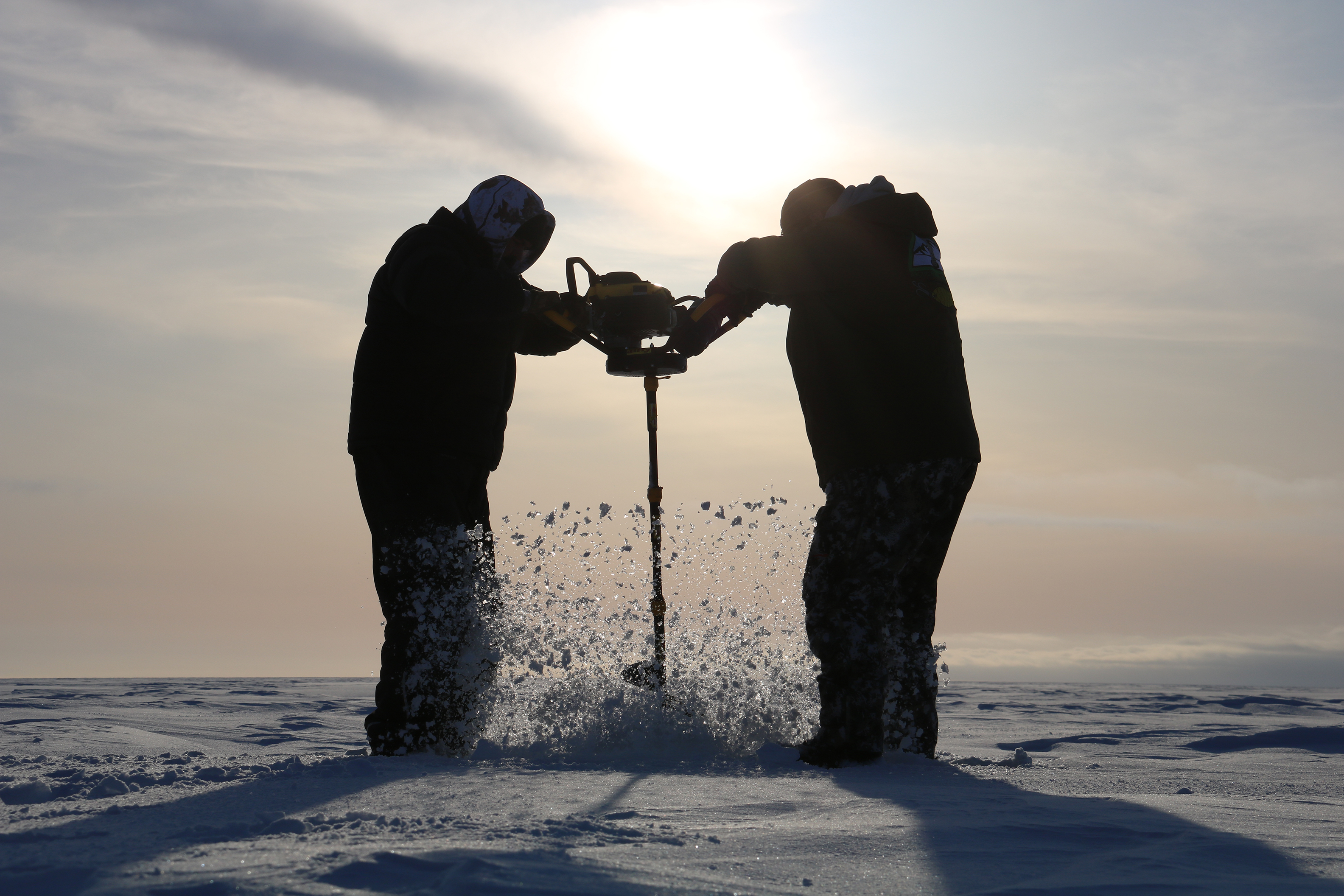
Pagel joined Tiffany and I on our second day on the ice. We fished for eight hours without a bite and then headed the snowmachines back to Kotzebue. Right in front of town, some locals had a couple fresh-caught sheefish laying on the ice. “Get your lines in the water, they’re everywhere,” one of them told us.
Soon we were drilling holes and jigging spoons. I flipped the bail on my ice fishing rod, letting the big lure free-fall. Before I could close the bail, line rapidly peeled off the spool. Immediately the fish felt big. Nearly 10 minutes into the battle, the sheefish finally began to tire, but I couldn’t get it through the ice hole. Tediously, I gave the fish a bit of slack line, then pulled it tight hoping to align its mouth with the bottom of the ice hole. It wouldn’t fit.
After several tries I finally felt the head of the sheefish slip into the hole. Grabbing the 60-pound braided line, I carefully lifted the fish through the ice. Its round body was tight in the hole, but I kept pulling, trusting the braid and my knot. A rush of water surged out of the hole, ahead of the sheefish. I reached in to grab the fish by the gills, and I’ll never forget the gasps let out by the locals as I hoisted the monster sheefish into the sky. Tipping the scales to just over 40-pounds, it was the biggest sheefish of my life.
“Looks like we found ‘em,” smiled Pagel, who was quietly battling a sheefish of his own, a cigar clutched in his teeth. Tiffany worked her spoon, and soon she was locked in battle with a hard-fighting fish as well. The fish would run, Tiff’ would gain line, and quickly it was stripped out, again. Eventually the sheefish tired and Tiffany pulled a 25-pound beauty from the ice. Her very next cast yielded a 22-pounder. Over the next several minutes Tiffany pulled three more shiny sheefish from that hole. The smallest was 18-pounds.
I’d been so focused on helping Tiff’ I failed to notice the fish Pagel was amassing. He held up a 23-pounder and added it to the stack. I hooked another monster. This one wouldn’t fit through the hole, no matter what we tried. That’s when one of the locals told me they catch them up to 70 pounds in the summer, on rod and reel.
Many villagers soon gathered on the ice. “Word travels fast when the sheefish move close to town, and it’s great for kids and elders,” Pagel said. Pagel guides for sheefish mid-March through the third week of April. “They’re always cruising the bay, but the best weather for targeting sheefish is when spring starts showing up,” Pagel said. “It’s warmer and there’s a lot of daylight then.”
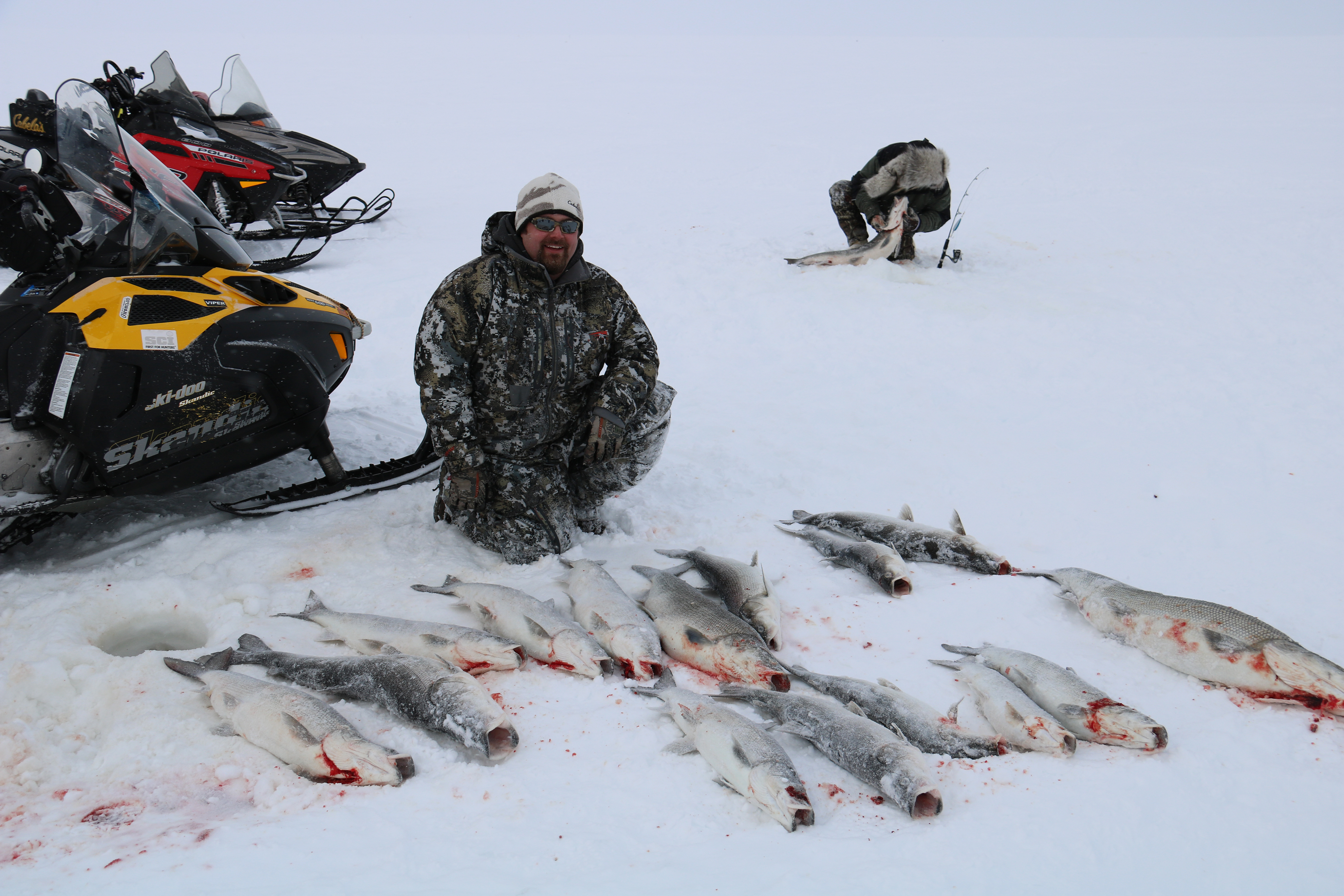
Pagel offers fully guided sheefish trips as well as do-it-yourself options. The DIY gear includes a snowmachine and cargo sled, propane powered ice auger, popup shelter, propane heater, ice scoop, chairs, and fishing gear. He provides lodging at his spacious home which is comfy and convenient (visit Arctic Fishing Adventures for details).
Since first fishing with Pagel in his pre-guiding years — in 2016 and a couple times after that — he’s gotten dialed in to this fishery. Like any hunting or fishing trip, there are never any guarantees. But if you put in your time and you’ll usually be rewarded.
Read Next: The Best Winter Jackets for Extreme Cold, Tested at 20 Below in Alaska
The Real Experience
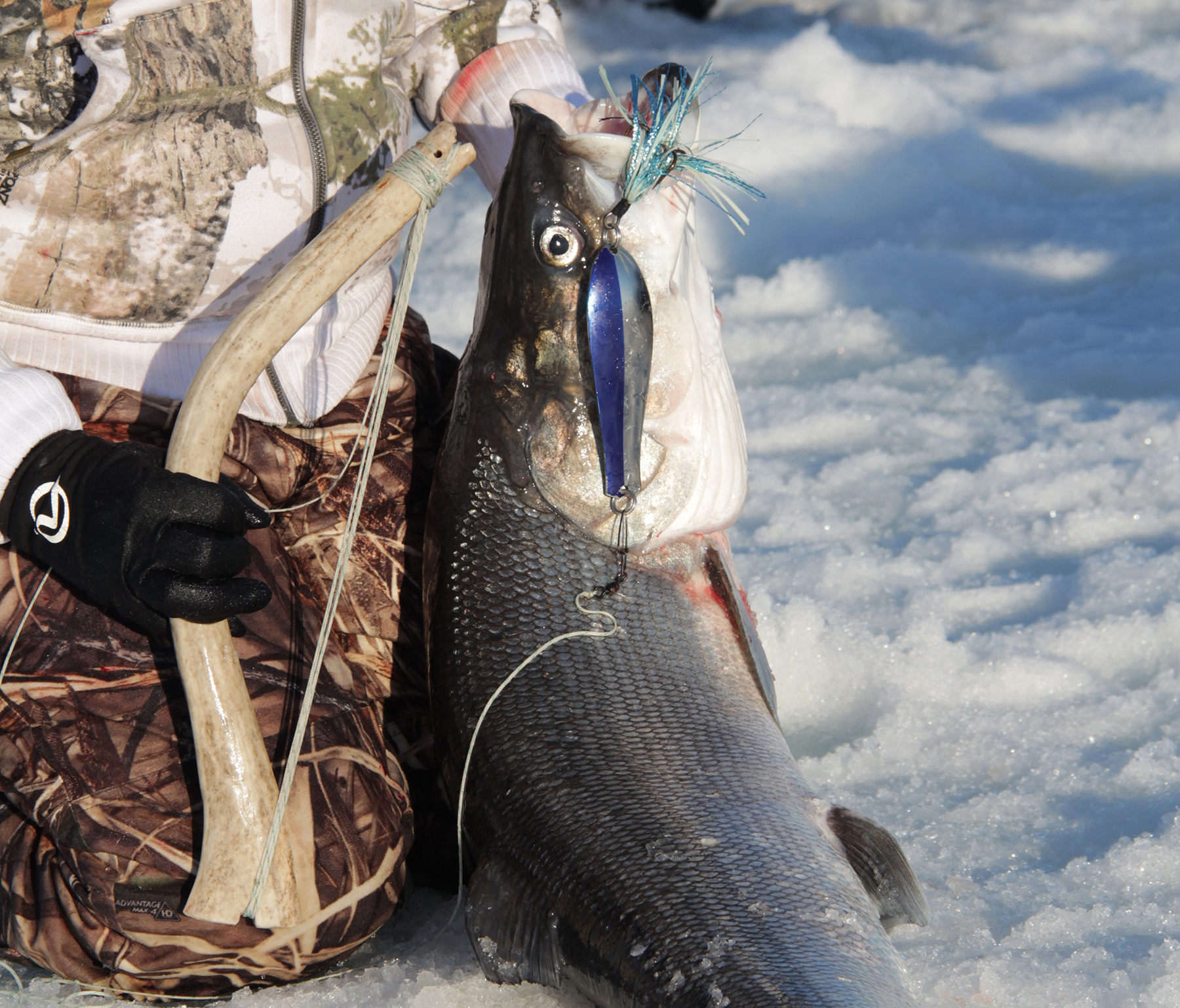
Over the next two hours everyone caught sheefish. Tiffany and I were having a blast. Pagel smiled in relief. A few elders were on the ice, fishing with their niksiks. They let Tiffany and I try them. With 300-pound Dacron, it was a solid setup. When you hook a sheefish, rarely do you lose it.
Bundled in traditional fur-ruffed parkas, grandchildren at their side, elders were in their element. Spirits were high. Our day on the ice was developing into a joyous subsistence experience.
When the sheefish bite slowed, everyone began cleaning fish. Pagel, Tiffany, and I had caught a sled full, plenty to keep us busy as we listened to stories from the locals. Everyone was content.
We’ve been fortunate to fish many parts of Alaska over the past 34 years, but this experience made Tiffany and I reflect upon and appreciate how our life together had started. We had no store in Point Lay. We did nine months worth of grocery shopping at once in Anchorage, then had it flown into the village on bush planes. The meat we ate was what we hunted and caught.
When we moved to Anaktuvuk Pass in 1993, I ran a 200-mile wolf trapline with a local Inupiat man, the late Ben Hopson. That’s when I first tasted sheefish. Hopson and I crossed trails with a trapper from another village, 130 miles from home. We had Dall sheep meat. The man had sheefish. We exchanged meals. It was some the best fish I’d ever tasted. I took some home to Tiffany to cook and she loved it.
During our Kotzebue trip we also went ptarmigan and snowshoe hare hunting, rode with a dog sled team that had competed in the Iditarod, and enjoyed walking around the village and its outskirts. It was a big city compared to the villages we once called home. This one had stores, flush toilets, and commercial airlines. We had none of those conveniences.
Read Next: A Caribou Hunting Adventure in Alaska, No Guides Required
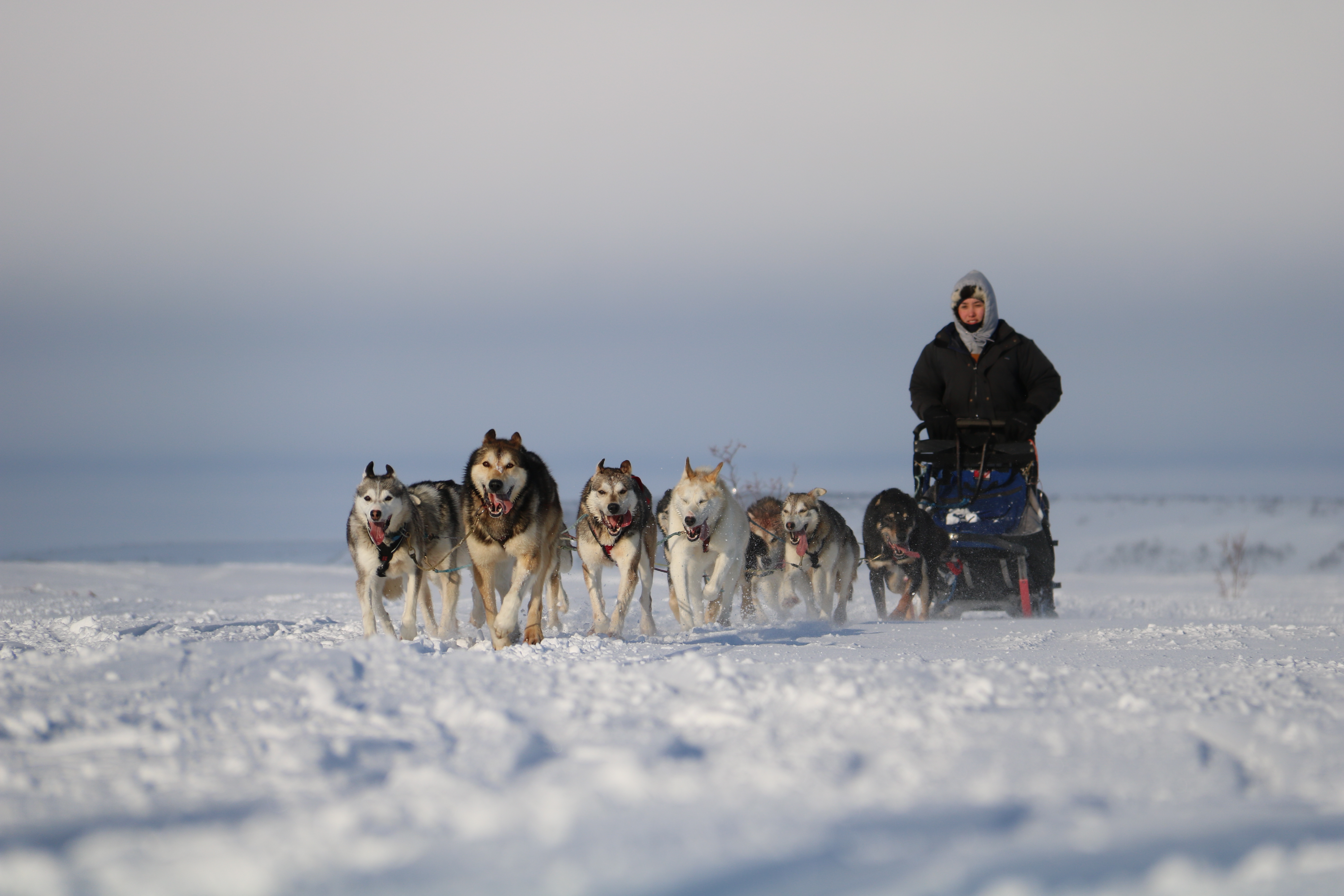
Tiffany and I took home 100 pounds of hefty sheefish fillets. The meat is sweet and it’s our favorite fish to smoke, even over salmon. Every time we sank our teeth into those tasty sheefish, we were taken back to our special evening on the ice with the locals — and to our life together in the Arctic.
For personally signed copies of Scott Haugen’s best selling book, “Hunting The Alaskan High Arctic,” visit scotthaugen.com
The post Ice Fishing for Giant Sheefish in the Arctic Is a True Winter Adventure appeared first on Outdoor Life.
Source: https://www.outdoorlife.com/fishing/ice-fishing-sheefish/


